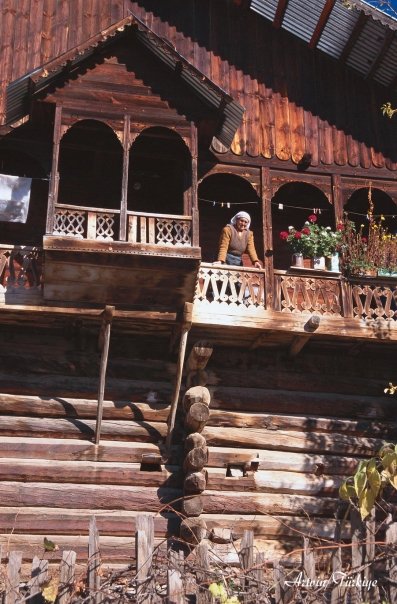The residences of northern Anatolia — stone, brick, frame, and log alike — seem to share certain characteristics. Often hip-roofed and set on tall masonry foundations (and, in more mountainous locales, built into hillsides), Pontic houses tend to use a latticework of half-timbering, with stone nogging and projecting overhangs.
The region's better-constructed log buildings are similar, in size and form, to their half-timbered counterparts. Many, it seems, are fashioned from closely fitted planks. (I'm aware, of course, that classifying plank construction as a subtype of log construction is problematic.) Some Pontic domiciles would look quite at-home in the Swiss Alps.
Still other Pontic structures rest on stilt-like wooden supports. These may be granaries or storage sheds, elevated to prevent wildlife from devouring valuable food stores.
If my explorations are any indication, Artvin Province, which borders Georgia, deserves the epithet "log building capital of Turkey." Atop the rocky Kaçkar highlands, well above the tree line, stand clusters of particularly tiny log dwellings, no doubt constructed of timber sourced from lower altitudes. Scattered across Artvin Province are innumerable chalet-esque homes; a quick Google search reveals hundreds of photos of such buildings.
Precisely what relationship connects modern Turkey's homes to classical-era Pontic abodes, I can't say. But it's likely, given the region's isolation, that its residents could trace their traditions — directly or indirectly — to the time of Strabo and Vitruvius.
 |
| Half-timbered house with tile roof. Budak, Çamaş District, Ordu Province. Image by Yılmaz Kilim, March 2010, from Wikimedia Commons. |
 |
| Hillside half-timbered dwelling. Note the generous second-story overhang. Tuğlacık, Yağlıdere District, Giresun Province. Photo by Zeynel Cebeci, September 2015, from Wikimedia Commons. |
 |
| One-story half-timbered house. Kemaliye, Giresun Province. Photo by Hüsamettin Alpaslan, July 2011, used courtesy of Wikimedia Commons. |
The region's better-constructed log buildings are similar, in size and form, to their half-timbered counterparts. Many, it seems, are fashioned from closely fitted planks. (I'm aware, of course, that classifying plank construction as a subtype of log construction is problematic.) Some Pontic domiciles would look quite at-home in the Swiss Alps.
 |
| Round-log house with cantilevered upper story. Şavşat District, Artvin Province. Artvin Province borders Georgia and harbors a significant Georgian (and Laz) population. Image by Sairzamanlar, used courtesy of Wikimedia Commons. Date unknown. |
 |
| Two-story plank house. Despite its size, the building is haphazardly constructed — note the jutting floor joists, untrimmed planks, and wide roof overhang. Taşören, Çaykara District, Trabzon Province. Photo by İhsan Kılıçoğlu, July 2010, from Wikimedia Commons. |
 |
| Hillside buildings in Tamdere, Dereli District, Giresun Province. At least nine log structures are visible. Some are houses (with cantilevered porches); others, round-log barns oddly reminiscent of eastern Ohio's tobacco kilns — replete with roof purlins. Image by Zeynel Cebeci, September 2016, from Wikimedia Commons. |
 |
| Pınarlar, Dereli District, Giresun Province. Compare these buildings to the ones depicted above. Pınarlar lies about 12 miles north of Tamdere. Image by Zeynel Cebeci, September 2016, courtesy of Wikimedia Commons. |
Still other Pontic structures rest on stilt-like wooden supports. These may be granaries or storage sheds, elevated to prevent wildlife from devouring valuable food stores.
 |
| Lilliputian plank house (or shed). Sancaklıtepe, Keşap District, Giresun Province. Photo by HuSeYiN, August 2009, from Wikimedia Commons. |
 |
| Connected plank buildings of unknown use. Coşandere, Maçka District, Trabzon Province. Photo by Haluk Comertel, April 2008, from Wikimedia Commons. |
If my explorations are any indication, Artvin Province, which borders Georgia, deserves the epithet "log building capital of Turkey." Atop the rocky Kaçkar highlands, well above the tree line, stand clusters of particularly tiny log dwellings, no doubt constructed of timber sourced from lower altitudes. Scattered across Artvin Province are innumerable chalet-esque homes; a quick Google search reveals hundreds of photos of such buildings.
 |
| Crude log houses. Kocabey, Şavşat District, Artvin Province. Photo by Sairzamanlar, October 2014, from Wikimedia Commons. |
Precisely what relationship connects modern Turkey's homes to classical-era Pontic abodes, I can't say. But it's likely, given the region's isolation, that its residents could trace their traditions — directly or indirectly — to the time of Strabo and Vitruvius.

No comments:
Post a Comment